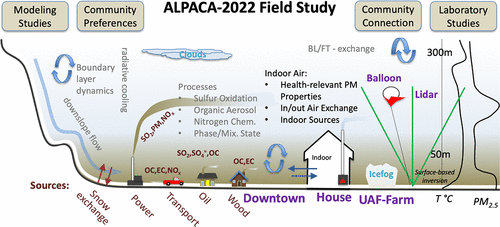
Overview of the Alaskan Layered Pollution and Chemical Analysis (ALPACA) Field Experiment
William R. Simpson, Jingqiu Mao, Gilberto J. Fochesatto, Kathy S. Law, Peter F. DeCarlo, Julia Schmale, Kerri A. Pratt, Steve R. Arnold, Jochen Stutz, Jack E. Dibb, Jessie M. Creamean, Rodney J. Weber, Brent J. Williams, Becky Alexander, Lu Hu, Robert J. Yokelson, Manabu Shiraiwa, Stefano Decesari, Cort Anastasio, Barbara D’Anna, Robert C. Gilliam, Athanasios Nenes, Jason M. St. Clair, Barbara Trost, James H. Flynn, Joel Savarino, Laura D. Conner, Nathan Kettle, Krista M. Heeringa, Sarah Albertin, Andrea Baccarini, Brice Barret, Michael A. Battaglia, Slimane Bekki, T.J. Brado, Natalie Brett, David Brus, James R. Campbell, Meeta Cesler-Maloney, Sol Cooperdock, Karolina Cysneiros de Carvalho, Hervé Delbarre, Paul J. DeMott, Conor J.S. Dennehy, Elsa Dieudonné, Kayane K. Dingilian, Antonio Donateo, Konstantinos M. Doulgeris, Kasey C. Edwards, Kathleen Fahey, Ting Fang, Fangzhou Guo, Laura M. D. Heinlein, Andrew L. Holen, Deanna Huff, Amna Ijaz, Sarah Johnson, Sukriti Kapur, Damien T. Ketcherside, Ezra Levin, Emily Lill, Allison R. Moon, Tatsuo Onishi, Gianluca Pappaccogli, Russell Perkins, Roman Pohorsky, Jean-Christophe Raut, Francois Ravetta, Tjarda Roberts, Ellis S. Robinson, Federico Scoto, Vanessa Selimovic, Michael O. Sunday, Brice Temime-Roussel, Xinxiu Tian, Judy Wu, and Yuhan Yang
ACS ES&T | Air
ACS EST Air 2024, 1, 3, 200–222
Publication Date: February 21, 2024
Copyright © 2024 The Authors. Published by American Chemical Society.
This publication is licensed under CC-BY 4.0.
OPEN ACCESS
Abstract.
The Alaskan Layered Pollution And Chemical Analysis (ALPACA) field experiment was a collaborative study designed to improve understanding of pollution sources and chemical processes during winter (cold climate and low-photochemical activity), to investigate indoor pollution, and to study dispersion of pollution as affected by frequent temperature inversions. A number of the research goals were motivated by questions raised by residents of Fairbanks, Alaska, where the study was held. This paper describes the measurement strategies and the conditions encountered during the January and February 2022 field experiment, and reports early examples of how the measurements addressed research goals, particularly those of interest to the residents. Outdoor air measurements showed high concentrations of particulate matter and pollutant gases including volatile organic carbon species. During pollution events, low winds and extremely stable atmospheric conditions trapped pollution below 73 m, an extremely shallow vertical scale. Tethered-balloon-based measurements intercepted plumes aloft, which were associated with power plant point sources through transport modeling. Because cold climate residents spend much of their time indoors, the study included an indoor air quality component, where measurements were made inside and outside a house to study infiltration and indoor sources. In the absence of indoor activities such as cooking and/or heating with a pellet stove, indoor particulate matter concentrations were lower than outdoors; however, cooking and pellet stove burns often caused higher indoor particulate matter concentrations than outdoors. The mass-normalized particulate matter oxidative potential, a health-relevant property measured here by the reactivity with dithiothreiol, of indoor particles varied by source, with cooking particles having less oxidative potential per mass than pellet stove particles.
